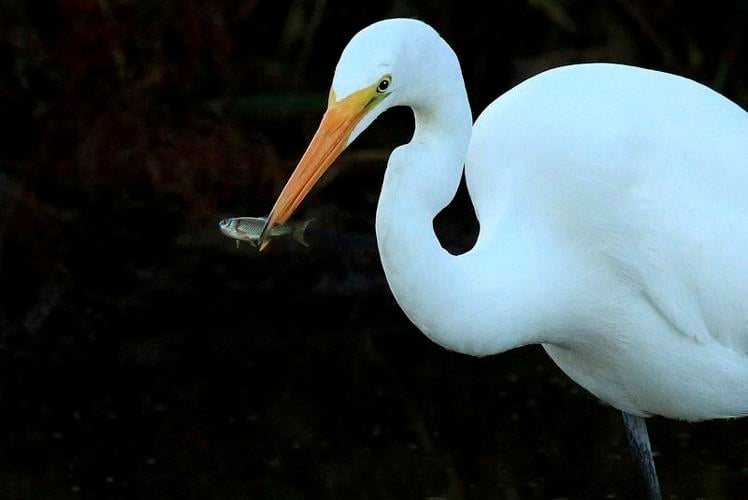I had stopped at one of the smaller marshes in the Tonawanda Wildlife Management Area to check out some ducks and noticed a great egret hunting off to the side in a field.
After checking out the ducks I saw that the great egret was moving up over the marsh berm to hunt along the water’s edge. I decided to sit awhile and see if he offered any good images, as he was a mature bird with nice long plumes hanging down along his sides and butt. Well, he accommodated me by moving closer and not paying much attention to the guy with the camera sticking out a window.
Thirty years ago, the sight of one of these great blue heron-sized birds was pretty rare around here. I remember my first sighting, over in Cayuga Pool during a marsh draw-down. A big, white bird suddenly took flight right in front of me, and my immediate thought was it had to be an albino great blue heron. That wasn’t quite right, though; I later learned it was a great egret.
• • •
Over the past 15 years or so this bird’s numbers in “our swamp” have been growing and they do nest here now. They often roost in large numbers and in recent years I have had the good fortune to see as many as 200 of them roosting together in trees over water.
The great egret is not as big as the great blue heron but it appears to be because of the completely white body. The bill is yellow and and there is a greenish patch of skin between the base of the bill and eye on a mature breeding bird. Its legs are black and of course long for wading. Great egrets hunt for fish, frogs, tadpoles and other aquatic animals the same way herons do: by stabbing them with that long, sharp bill.
In the spring, a mature great egret, 2 to 3 years old, develops long feathers (plumes) on its back that hang down along its side and even past its butt. These plumes can be raised up and displayed during courtship and are quite impressive; so much so that at the turn of the 20th century the plumes were a huge hit in the ladies fashion world. In fact, the great egret came close to extinction at the hands of feather hunters, because these plumes fetched a high price which at the peak of the trade was the modern equivalent of $2,000 per ounce. To make matters worse, both sexes bore the fancy plumage, so hunters didn’t just target the males, they decimated entire rookeries. Every ounce of breeding plumes represented six dead adults, and each slain pair left behind three to five starving nestlings. Millions of birds died, and by the turn of the century this once common species survived only in the deep Everglades and other remote wetlands.
In 1911 New York State outlawed the sale of all native birds and their feathers, and other states soon followed suit. Passage of the Weeks-McLean Act (1913) and the Migratory Bird Act (1918) took the protections nationwide. Today the great egret has made a great comeback and he is now common even in the Alabama Swamp.
• • •
So, this great egret kept feeding right towards me and by now had accepted my van as part of his environment. He gave me some great images as he hunted along the shore but eventually went past me, which made the light angle poor. So I took a chance and started the engine. No problem. Then I backed the van along the shoulder of the road to keep the light angle in my favor. All that time I was fascinated by those long plumes as the wind swung them back and forth. He was now hunting only 16 yards away from me and even catching a minnow or a small bullhead periodically.
Well, as usual, I took too many photos and set myself up for hours of sorting and processing all those images! The next day the same egret gave me an even closer encounter and of course even more pictures.
While “baby sitting’’ this bird (several hours over a two-day period) other egrets flew by, giving me some nice flight shots. A great blue heron was likewise very cooperative. Then there was the pair of eagles that allowed me to put their images in my camera a number of times. While waiting for my egret to show up early in the morning Mother Nature gave me some fabulous sunrise shots too. The second morning on the way home I ran into a big beautiful pheasant rooster who also posed nicely for me. What a couple of wonderful days in the great outdoors seeing all of its beauty!
Look for great egrets along the shallows of the marsh edges. Their white bodies make them easy to spot. Stay in you vehicle, move up slowly and spend some time with them if they hold. You may get some very unique shots of them catching fish, preening or just perched in a tree with nice fall color background.
Doug Domedion, outdoorsman and nature photographer, resides in Medina. Contact him at (585) 798-4022 or woodduck2020@yahoo.com .

















Commented
Sorry, there are no recent results for popular commented articles.